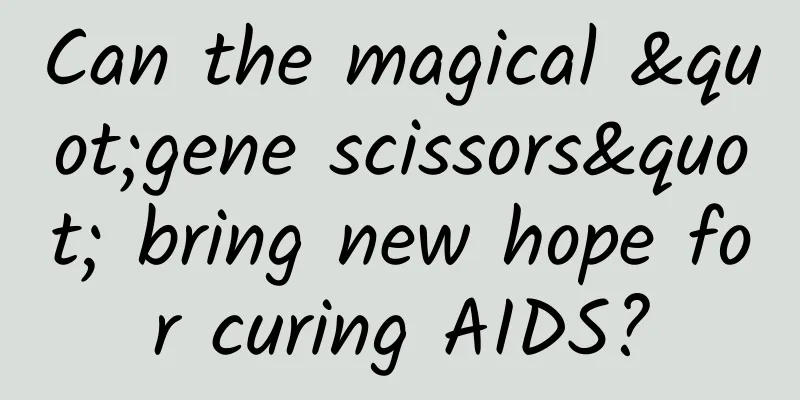Can the magical "gene scissors" bring new hope for curing AIDS?

|
Author: Duan Yuechu AIDS is a serious immune system disease caused by infection with the human immunodeficiency virus (HIV). Since the 1980s, AIDS has become a major public health issue worldwide. According to the World Health Organization, as of the end of 2019, 38 million people worldwide were infected with HIV and more than 32 million people had died from diseases caused by AIDS. Gene editing is a technology that modifies the human genome. The most famous and widely used one is the CRISPR gene editing technology. CRISPR stands for clustered regularly interspaced short palindromic repeats, an immune system naturally found in certain bacteria and archaea. Scientists use the Cas9 protein in the CRISPR system to precisely edit, add or delete genetic sequences. The emergence of CRISPR technology has brought a revolution to the field of gene editing because it is more efficient, precise and cheaper than traditional gene editing technologies. CRISPR can be used to treat a variety of diseases, including genetic diseases, cancer, infectious diseases, etc. It has been successfully used in the laboratory to change the genes of human babies, transform animals for research, and treat patients with sickle cell disease. Excision BioTherapeutics is a biotechnology company focused on gene editing therapy. They recently conducted an experiment to try to use CRISPR technology to permanently cure HIV. The goal of the experiment is to implant the CRISPR gene editing tool into the body of an HIV carrier and use it to cut and destroy the HIV in the patient's body, thereby achieving a therapeutic effect. In this experiment, scientists at Excision BioTherapeutics first extracted immune cells from three HIV carriers and introduced CRISPR gene editing tools into these cells. Through precise gene editing, the CRISPR system will recognize and cut the DNA of HIV, rendering the virus inactive. The edited cells will be reinjected into the patient's body to replace the previously infected cells. Preliminary experimental results show that immune cells edited with CRISPR genes successfully eliminated HIV. This means that CRISPR technology has the potential to treat AIDS. However, the current experiment is small in scale, and further research and clinical trials are still needed to verify its safety and effectiveness. The success of this experiment is expected to provide a new breakthrough in the treatment of HIV. If CRISPR technology can be proven to be safe and effective, it is expected to become a reliable treatment method and bring good news to AIDS patients. References: https://www.technologyreview.com/2023/10/25/1082306/gene-editing-crispr-hiv-experiment/ |
>>: Blizzard is online! Why do we need artificial snow?
Recommend
Are wolfberry leaves cooling in nature?
Everyone must have seen the bright red "drie...
I was healthy, how did I get tuberculosis? | World Tuberculosis Day
March 24, 2025 The 30th World Tuberculosis Day Th...
The efficacy and function of Datura root
We know that there are many kinds of Chinese medi...
Can Cordyceps and Panax notoginseng be eaten together?
Cordyceps and Panax notoginseng are both common C...
What are the effects of Yu Li Ren?
Prunus mume is a relatively important Chinese med...
The "Nine-tailed Fox" who is unwilling to be a relative of human ancestors is not a good turtle
Starting from the birth of the first fish during ...
The iron tree finally blooms, which is much more difficult than "the iron tree blooms"!
Recently, the news that a very small wild plant s...
Xanthium sibiricum pictures
Xanthium sibiricum is a warm and spicy antipyreti...
What are the medicinal values of Polygonum multiflorum
I believe everyone knows about the medicinal valu...
Can Artemisia capillaris lower blood sugar?
Nowadays, our living standards are constantly imp...
Hawthorn and brown sugar
Anyone who has eaten hawthorn directly should kno...
Immerse yourself in the "rhythm" of the sun! What did the solar exploration satellite "Xihe" discover?
Author: Duan Yuechu and Huang Yanhong The sun, a ...
The efficacy and function of the incense burner
Tianxianglu is a relatively familiar traditional ...
The Chang'e-6 rover will be launched around 2024 to collect lunar soil from the far side of the moon.
Recently, the National Space Administration annou...
@You who are afraid of sugar: Is there any kind of sugar that is good for the body? What kind of sugar is this?
Sugar is an essential nutrient in our lives, but ...





![[Popular Science of Chinese Military Technology] From "nothing to nothing" to "hitting the target from a hundred steps away", the evolution of tank artillery aiming](/upload/images/67f0a87f28ce3.webp)



